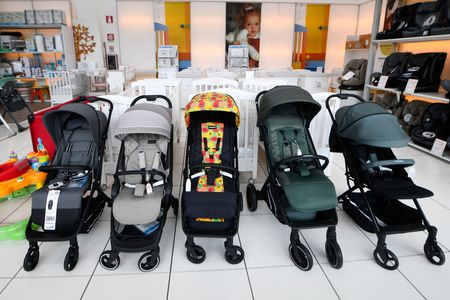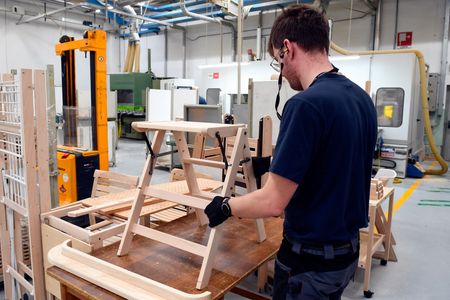By Claudia Cristoferi, Philippe LeroyBeaulieu and Alvise Armellini
MILAN (Reuters) -Only two manufacturers remain in northern Italy’s once thriving industrial district for baby and child products, after years of falling births and competition from abroad forced many of the small-scale family-owned businesses to close.
Bergamo province was home to around a dozen factories in the 1970s and 1980s, turning out high chairs, cribs, toys and prams, but the market collapsed as the number of births in Italy shrank by more than a third over the last 20 years.
One of those to remain, manufacturer Foppapedretti, has managed to buck the industry trend thanks to early diversification, but it needs to keep innovating and is considering expanding into products for Italy’s many elderly.
Like many of its former Bergamo peers, it sprung up during Italy’s post-war economic and baby boom. Founder Ezio Foppa Pedretti began making wooden toys in 1945 out of the offcuts from his uncle’s umbrella handle factory.
“We started out as a toy manufacturer, then focused on nursery products, but we soon realised that a major demographic decline was looming,” Chairman Luciano Bonetti said. They used their experience with wood to expand into household, furniture and gardening items from the 1980s.
Around 1990, his company typically sold around 100,000 highchairs and 80,000 baby beds a year. “Today if we sell 30,000 baby beds it is a golden year”, Bonetti said.
Nevertheless, annual turnover has remained constant since 2019 at around 45 million euros ($50 million), while some industry peers have seen falls of 20-30%.
Births in Italy, the EU’s third most populous country, hit a record low of some 370,000 in 2024. The fertility rate has slumped to 1.18, below an EU average of 1.38 in 2023, and far below the 2.1 needed for a steady population. Italy’s Prime Minister Giorgia Meloni has made encouraging more women to give birth a priority.
“We are facing a birth crisis, which in Italy has progressively eroded more than 35-40% of the market (for children’s products)”, Fiom Cgil trade unionist Adriana Geppert told Reuters. Competition from low-cost producers in China was another major challenge at home and abroad.
Two years ago, a group of manufacturers for child and baby products even produced a short fictional documentary, imagining a dystopian scenario in which by 2050 only one baby would be born in Italy, as a way of highlighting the urgent demographic challenges facing the country.
Alessandro Rosina, a professor of demography and social statistics at the Catholic University of Milan who featured in the documentary, said Italy’s situation was particularly alarming.
“The film aims to get people to think about the present situation and look ahead to 2050 with the warning: ‘be careful – the choices that we make or don’t make now have consequences on our future,'” Rosina said.
PRODUCTS FOR ELDERLY
Bonetti said he was considering branching out further into products for senior citizens like reclining armchairs, even if the market is crowded, since it is a fast-growing sector in increasingly grey-haired Europe.
“There might still be room for us – after all, these would be the same customers who bought our children’s and household items over their lifetimes and who know the quality of our products.”
Other firms are under pressure to diversify, but it may already be too late.
“Companies can only suffer at this moment”, said Gianfranco Ranieri, president of industry lobby Assogiocattoli that represents manufacturers of children’s goods. “80% of our members have a turnover of less than 8 million euros. They do not have the capacity to invest.”
The other company that remains in the Bergamo district, Cam – Il Mondo del Bambino, struck a deal in April with unions for 35 voluntary redundancies out of a total workforce of around 140, Fiom Cgil trade unionist Manuel Carrara said.
Unions said they suggested a switch to production of prams (strollers) for pets or frames for the elderly. In a statement to Reuters, Cam said the market for pets was already crowded, with well-established companies with strong brands and low labour costs, while selling products for the elderly was not viable as many of these were classed as medical devices, for which it did not have the expertise.
However, Cam said it would be open to producing for other brands, offering its manufacturing capacity.
Italy’s population is not only shrinking, it is also aging, with the highest median age in the EU, at 48.7 years. Where baby nappies were once heavily advertised on TV, now adverts for incontinence diapers for adults are becoming more common.
Consumer goods company Fater, an Italian joint venture between local pharma group Angelini and U.S. giant Procter & Gamble said in its latest annual report that absorbent products for adults had grown steadily in recent years, becoming a major pillar of growth in Italy.
($1 = 0.9001 euros)
(Reporting by Claudia Cristoferi, Philippe Leroy Beaulieu and Alvise Armellini; Editing by Alexandra Hudson)















